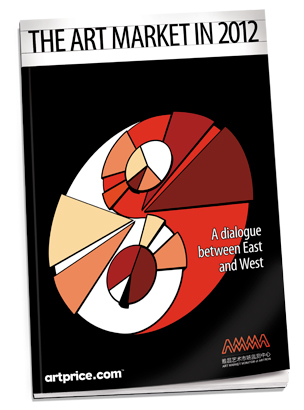Price has recently released its annual global art market report. New for this year is an alliance with Artron, and information service on the art market in China. The 88 page report gives an introduction and then looks at the art market in the West followed by the art market in the East.
I have yet to read the full report, but I wanted to get word out that it has been published and is now available It always has good content for appraisal market analysis.
Click HERE to download the PDF report.
Art Price states about the report
Source: Art Price
For this study of the global art market in 2012, Artprice has formed an alliance with Artron, the leading information service on the art market in China within the Greater Asia region, in order to provide the best possible overview of the art auction market.
For years, Artprice has taken the utmost interest in collecting the data of the Asian art market and more especially the Chinese market. However, Artprice was missing a key element: the cultural and sociologic analysis that key actor Art Market Monitor of Artron (AMMA) only could provide, according to Thierry Ehrmann, the founder and CEO of Artprice. With the art market now bipolar, entering into a dialogue between East and West has enabled us to come to an unprecedented cross-cultural analysis of the market.
In fact, we are analysing a bipolar art market that has grown in China and the West and at different speeds in different cultural terrains and according to different standards.
There has of course been a globalisation effect due to the dematerialisation of the art market through the Internet and the nomadic nature of collectors. And of course it is clear that bridges have been built between East and West and that the creation, supply and demand of art sometimes overlap at certain points. But we cannot say that art has become totally homogeneous. On the contrary, the art market exacerbates cultural differences by reflecting the gamut of artistic choices. Chinese collectors are not inclined to buy a Western piece of art that they find is too far removed from their cultural parameters. Instead, they prefer traditional styles, ancient calligraphy and, more recently, contemporary “experimental” ink art. Likewise, Western collectors mainly buy the works of artists who speak their language, including some Asian artists who have assimilated Western art history.
So the idea of a globalised art market should be taken with a pinch of salt. In any case, it is a little premature for Western and Chinese readers to be finding their bearings in an analysis of the global art market that is bent on combining information from East and West at all costs. In order to provide a clear and transparent analysis for our entire global readership, this year our report is made up of an introduction that covers the results of art sales around the world in 2012, followed by two distinct chapters. The first of these concentrates exclusively on the art market in the West and Artprice data, while the second focuses on art in China and Artron data. This fertile relationship between Artprice and Artron has led us both to examine our areas of overlap and divergence and to look at the way a new geopolitics is evolving in the art market of the 21st century.


No comments:
Post a Comment